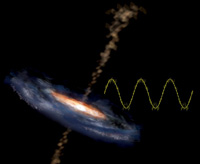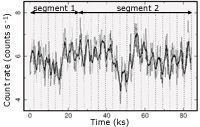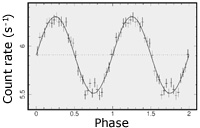XMM-Newton detection of QPO in RE J1034+396 important for theoretical understanding of AGN
17 September 2008
The first detection of strong, quasi-periodic oscillations (QPO) in the X-ray emission of an active galaxy (RE J1034+396) has been reported by a team of scientists from the University of Durham. Their result, obtained using data collected with XMM-Newton, appears in this week's issue of Nature.Unveiling the power houses of AGN
 |
|
Figure 1 Artist's impression of a super-massive black hole |
Accretion onto super-massive black holes (106-109 solar masses) is suspected to be the ultimate energy source powering active galactic nuclei. The physics of accretion onto a black hole suggests that the mass of the black hole only acts as a scaling parameter for the observables of the system. Apart from this, super-massive black holes can be considered as scaled-up versions of stellar-mass (about 10 solar masses) black holes, of which a couple of tens of well studied examples are known in our Galaxy. It can therefore be expected that studies of extragalactic black holes should reveal the same phenomena that are observed in their Galactic siblings.
Probing the physics of accretion
Timing analysis of the X-ray radiation from Galactic black holes is one of the most powerful tools used to probe the physics of accretion. The power density spectrum usually exhibits two components: a band-limited aperiodic variability, and quasi-periodic oscillations. The latter appear as a well-resolved power density peak, and indicate the existence of variability within a narrow frequency range.
The appearance of QPOs tracks the evolution of the source through different accretion states. High-frequency QPOs are thought to originate close to the innermost stable orbits around the black hole. They are, in a sense, signals sent by matter orbiting in a highly curved space-time, just before disappearing inside the black hole's horizon.
QPOs are commonly observed in Galactic black holes, and astronomers have been looking for them in active galactic nuclei without success. Until now.
QPO revealed in long XMM-Newton observation
 |
|
Figure 2 XMM-Newton light curve of RE J1034+396 (from Gierlinski et al., 2008) |
 |
|
Figure 3 Folded light curve of RE J1034+396 (from Gierlinski et al., 2008) |
Marek Gierlinski and colleagues analyzed 91ks of XMM-Newton data from RE J1034+396, an active galactic nucleus classified as a narrow-line Seyfert 1. This type of AGN is believed to host a central black hole that is less massive than those normally assumed for AGN of comparable luminosity.
A visual inspection of the light curve showed clear evidence for a periodic signal (see Figure 2). This was confirmed by a periodicity analysis of the data which returned a strong peak at about 3600s (see Figure 3). Further analysis showed that the nature of the periodicity changed during the observation. For the final 70ks the signal was highly coherent while for the first 25ks additional minima and phase shifts were observed. This observation leads the authors to conclude that the source is not truly periodic, but it exhibits quasi-periodic features similar to those observed in Galactic black holes.
Once the underlying aperiodic signal is removed from the power density spectrum, a clear peak, significant at about the 6 sigma level, can be identified at the frequency of 2.7×10-4Hz. The signal is highly coherent (quality factor ~ 16), and the strength of the QPO depends on energy, increasing from 2% in the 0.2-0.3 keV band to 10% above 1keV.
Estimating the mass of the black hole
Existing estimates for the mass of the black hole at the centre of RE J1034+396 vary by close to two orders of magnitude between several 105 to a few 107 solar masses.
Gierlinski and colleagues have applied their new results to estimate the mass of the black hole using several methods.
If the periodicity observed is interpreted as due to matter in the innermost stable keplerian orbit around the black hole, the mass of the latter would be of the order of 107 solar masses.
Another method of deriving the mass is to consider the nature of the QPO. In Galactic black holes QPOs can be broadly classified as low and high frequency, with the characteristic frequency scaling inversely to the mass of the black hole. If the QPO observed in this XMM-Newton data is taken to be of the low frequency variety (which would be the preferred choice given its high coherence), then the inferred black hole mass is only a few times 105 solar masses, suggesting that the system is radiating at several times the Eddington limit.
If the observed QPO is interpreted as belonging to the high-frequency category, the implied black hole mass is again of the order of 107 solar masses. Clearly more data are required in order to constrain the central mass of this system.
What is special about RE J1034+396?
The question remains as to why RE J1034+396 is the only active galactic nucleus for which a quasi-periodic oscillation has been unambiguously observed, in spite of the many observational campaigns carried out in the past. The authors argue that it could be sheer luck, or an indication that this source, which shows a spectrum peaking in the UV, has an unusually high accretion rate. If the latter, more targeted observational campaigns can be expected in the quest for a better understanding of the physics of accretion around super-massive black holes.
Related publications
Gierlinski, M., et al, "A ~1h X-ray periodicity in an active galaxy RE
J1034+396", Nature, 455, pp 369-371, 2008, DOI:10.1038/nature07277



